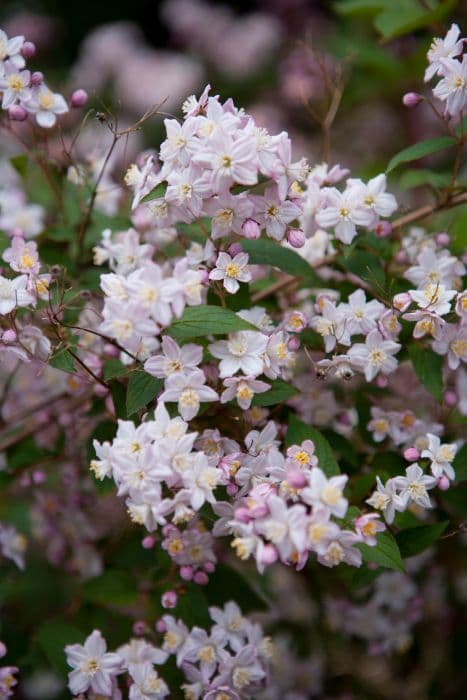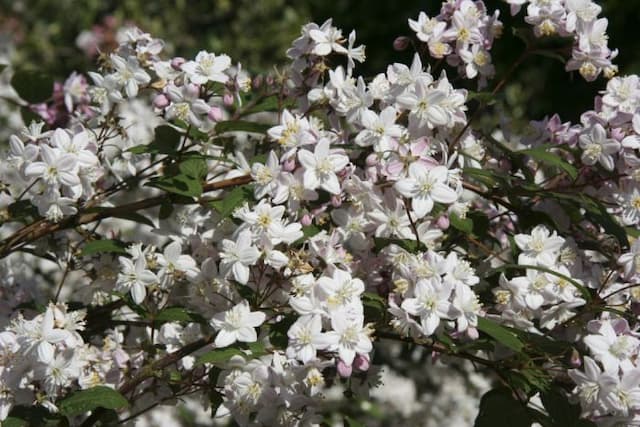Panicle Hydrangea Hydrangea paniculata 'Unique'

ABOUT
The Hydrangea paniculata 'Unique' is distinguished by its robust, showy flower heads that appear in mid to late summer. These flowers emerge creamy-white and as they mature, they transition to a deep pink, offering a splendid two-toned effect. The blossoms form large, cone-shaped clusters, known as panicles, and are quite dense with a profusion of small, closely packed flowers. The leaves of Hydrangea 'Unique' are ovate to oblong in shape, providing a lush backdrop of mid-green hues. They frequently turn to attractive shades of yellowish color as the cooler autumn seasons approach, adding another layer of visual interest to the plant. The branches are strong and sturdy, allowing them to hold the weight of the heavy blooms without drooping significantly. Overall, the plant has a rounded, bushy appearance that is lush and full, contributing to its popularity in garden landscapes as a beautiful ornamental shrub.
About this plant
 Names
NamesSynonyms
Panicled Hydrangea, Panicle Hydrangea, Peegee Hydrangea.
Common names
Hydrangea paniculata 'Unique'
 Toxicity
ToxicityTo humans
The common name for Hydrangea paniculata 'Unique' is simply hydrangea. Hydrangeas contain a compound called amygdalin which can release cyanide when ingested. However, poisoning from hydrangeas in humans is rare since large quantities must be consumed for a toxic effect. If ingested, symptoms may include stomach upset, vomiting, and diarrhea. In large doses, the cyanide releasing compounds can potentially lead to more serious symptoms such as dizziness, fainting, and even respiratory failure, although such severe reactions are exceptionally unusual from casual contact or small ingestions.
To pets
The common name for Hydrangea paniculata 'Unique' is hydrangea. Hydrangeas are considered toxic to pets such as cats and dogs. Just like in humans, the plant contains amygdalin, which can produce cyanide when metabolized. If a pet ingests hydrangea, it can lead to gastrointestinal upset, which may present as vomiting, diarrhea, and lethargy. In rare cases and with significant consumption, more serious symptoms such as depression, breathing difficulties, or increased heart rate could occur. Pet owners should keep hydrangeas out of reach and seek veterinary assistance if they suspect their pet has ingested part of the plant.
 Characteristics
CharacteristicsLife cycle
Perennials
Foliage type
Deciduous
Color of leaves
Green
Flower color
White
Height
6-8 feet (1.8-2.4 meters)
Spread
6-8 feet (1.8-2.4 meters)
Plant type
Shrub
Hardiness zones
3-8
Native area
China Japan
Benefits
 General Benefits
General Benefits- Ornamental Appeal: Hydrangea paniculata 'Unique' produces large, attractive white flower clusters that fade to pink, enhancing garden aesthetics.
- Seasonal Interest: Offers visual interest throughout the growing season, with flowers blooming from summer to fall.
- Wildlife Attraction: Can attract pollinators such as bees and butterflies, which are beneficial for the ecosystem.
- Durability: Known for being hardy and able to withstand cold temperatures, making it suitable for a variety of climates.
- Low Maintenance: Requires minimal pruning and care once established, making it ideal for busy gardeners.
- Versatility: Can be planted in borders, as a specimen plant, or in containers, offering flexibility in landscape design.
- Adaptability: Tolerates different soil types, though it prefers well-drained soil, making it adaptable to various garden conditions.
- Color Changing Blooms: The flowers can change color based on the soil pH, adding an element of surprise and variety to the garden.
 Medical Properties
Medical PropertiesThis plant is not used for medical purposes.
 Air-purifying Qualities
Air-purifying QualitiesThis plant is not specifically known for air purifying qualities.
 Other Uses
Other Uses- Floral arrangements: Hydrangea paniculata 'Unique' can add volume and texture to bouquets and centerpieces, with their large, cone-shaped flowers.
- Garden accent: Its distinctive flower heads can serve as focal points in garden design, especially when placed against a backdrop of green foliage.
- Dried flower displays: The blossoms of Hydrangea paniculata 'Unique' retain their shape and color when dried, making them popular for long-lasting arrangements.
- Hedge plant: When planted in a row, Hydrangea paniculata 'Unique' can form an attractive hedge with seasonal visual interest.
- Wildlife attraction: The flowers can attract pollinators like bees and butterflies to the garden, enhancing biodiversity.
- Gift plant: Due to its beauty and ease of cultivation, Hydrangea paniculata 'Unique' can be given as a gift to garden enthusiasts.
- Photography subject: The striking blooms are often used as subjects for botanical photography due to their size and intricate detail.
- Erosion control: The shrub's root system helps to stabilize soil on slopes or in areas prone to erosion.
- Grafting rootstock: Hydrangea paniculata 'Unique' can be used as rootstock for grafting other hydrangea varieties to create new cultivars with desirable traits.
- Seasonal interest: With blooms that change color from white to pink as they age, this hydrangea adds interest to the garden across multiple seasons.
Interesting Facts
 Feng Shui
Feng ShuiThe Hydrangea is not used in Feng Shui practice.
 Zodiac Sign Compitability
Zodiac Sign CompitabilityThe Hydrangea is not used in astrology practice.
 Plant Symbolism
Plant Symbolism- Heartfelt Emotions: Hydrangeas often symbolize deep feelings and heartfelt emotions, which can include gratitude, understanding, and sometimes even apology or regret.
- Vanity or Boastfulness: In some cultures, hydrangeas carry a negative connotation, symbolizing vanity or boastfulness due to their showy and abundant flowers.
- Abundance and Prosperity: The lush blooms of the hydrangea represent abundance and prosperity, making it a common gift for housewarmings or celebrations of new beginnings.
- Fourth Wedding Anniversary: Hydrangeas are also associated with the fourth wedding anniversary, symbolizing appreciation and enduring love between spouses.
 Water
WaterPeegee hydrangeas require consistent moisture and should be watered deeply once a week, providing about 1 gallon of water per plant. During hot or dry periods, water twice weekly to maintain soil moisture but avoid waterlogging. In the absence of rain or extreme heat, reduce watering to every other week. Ensure that the plant is watered at the base to avoid wetting the foliage, which can lead to fungal diseases.
 Light
LightPreegee hydrangeas thrive in a location where they can receive full sun to part shade. They perform best with morning sunlight and some afternoon shade, especially in hotter regions. An ideal spot would provide 4 to 6 hours of direct sunlight daily with some protection during the intense late afternoon sun.
 Temperature
TemperaturePeegee hydrangeas are hardy and can tolerate a wide range of temperatures, surviving in conditions as low as 5°F and as high as 95°F. However, the ideal growing temperature for these hydrangeas is between 65°F and 75°F. Ensure they are protected from harsh winter winds to prevent damage to the stems.
 Pruning
PruningPrune Peegee hydrangeas in late winter or early spring to remove dead wood and encourage new growth. They bloom on new wood, so cutting them back by about one-third each year promotes a healthier plant and larger blooms. The best time for pruning is before they begin to leaf out, typically between February and March.
 Cleaning
CleaningAs needed
 Soil
SoilThe best soil mix for the PeeGee Hydrangea should be well-draining, rich in organic matter, and slightly acidic to neutral, with a pH of 5.8 to 6.5. A mixture of 50% loam, 30% peat moss, and 20% perlite or pine bark fines creates an ideal environment for healthy root growth and water retention.
 Repotting
RepottingPeeGee Hydrangeas planted in containers may need repotting every 2-3 years, or when the root system outgrows the current pot. It's best to repot in late winter or early spring before new growth begins.
 Humidity & Misting
Humidity & MistingPeeGee Hydrangeas thrive in average garden humidity conditions. For best growth, maintain outdoor ambient humidity levels, avoiding extremely dry or overly moist air, which can impact health and bloom.
 Suitable locations
Suitable locationsIndoor
Place in bright light, ensure ample space for growth.
Outdoor
Plant in sun to part shade, shelter from strong winds.
Hardiness zone
3-8 USDA
 Life cycle
Life cycleHydrangea paniculata 'Unique', commonly known as panicle hydrangea, begins its life cycle as a dormant seed, which germinates in the spring when soil temperatures rise and moisture levels are adequate. After germination, the seedling stage involves the emergence of the radicle and plumule, followed by the development of juvenile leaves. As the plant matures into the vegetative stage, it forms a sturdy stem and a proliferation of leaves, increasing in size and mass. The hydrangea enters the flowering stage in the summer, producing large, cone-shaped clusters of creamy white flowers that may transition to pink or bronze as they age. Post-pollination, these flowers develop into seed capsules that eventually dry and release seeds for the next generation. In autumn, as temperatures cool, the hydrangea enters a period of dormancy, with leaves often changing color and dropping, and the plant's metabolism slowing down in preparation for winter.
 Propogation
PropogationPropogation time
Spring-Early Summer
The Hydrangea paniculata 'Unique', commonly known as 'Unique' panicle hydrangea, is typically propagated during the plant's dormant period, which occurs in late winter or early spring before new growth begins. The most popular method of propagation for this shrub is through softwood cuttings. This involves taking a cutting of about 5 to 6 inches long from a healthy, new growth stem that has not yet flowered. The lower leaves are removed, and the cut end is dipped into a rooting hormone powder to increase the chance of successful rooting. The cutting is then planted in a mixture of potting soil and perlite or sand to improve drainage, ensuring at least two sets of leaf nodes are below the surface. The pot should be covered with a plastic bag or placed in a propagator to maintain high humidity levels. Within a few weeks, the cutting should develop roots, after which it can gradually be acclimatized to outdoor conditions.








![Hydrangea [Early Sensation]](/_next/image?url=https%3A%2F%2Fplants-admin.emdemapps.com%2Fimages%2Fplants%2F%2Fimages%2F604b6150338db.png&w=640&q=75)
